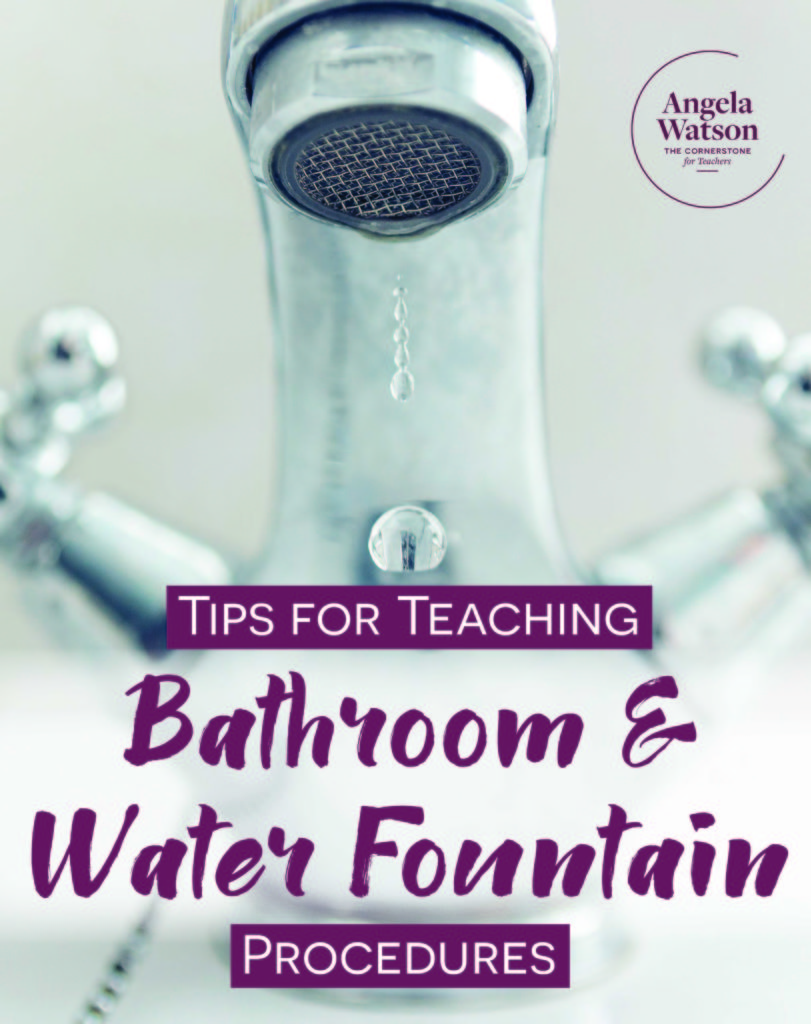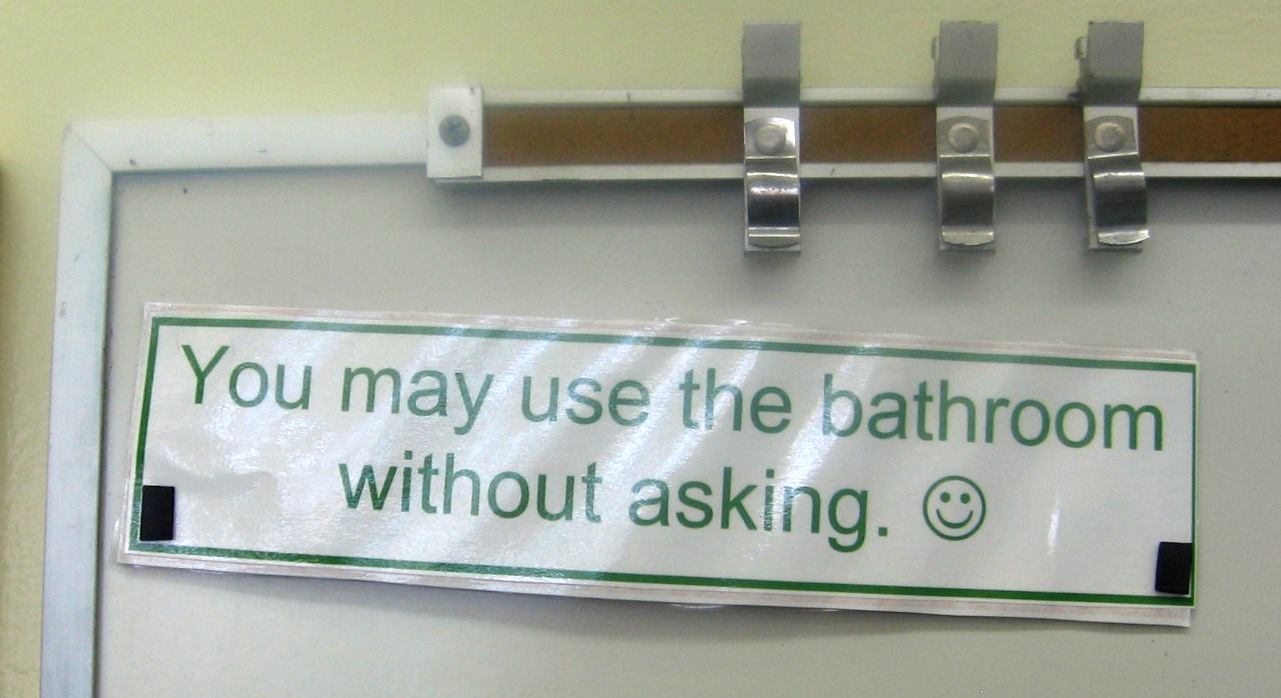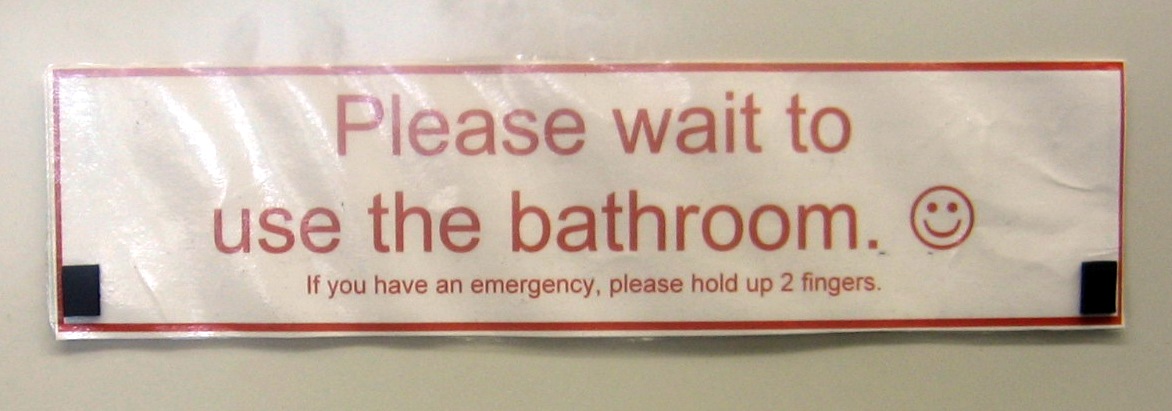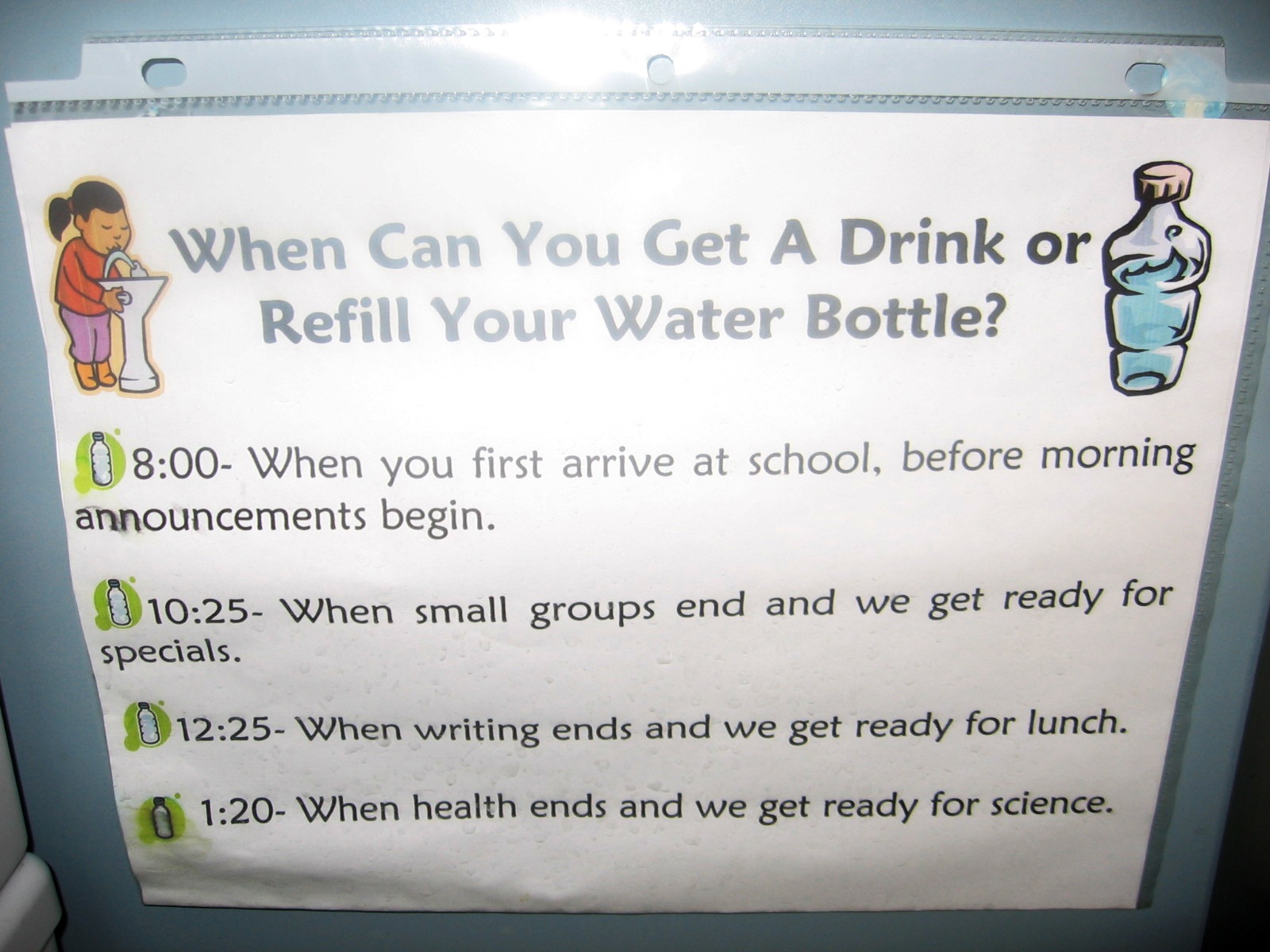Only a teacher would understand the need for an entire web page devoted to creating procedures for the bathroom, hallway, and water fountain! Neglecting to plan for these routines can cost you nearly a half an hour’s worth of instructional time each day. On this page excerpted from The Cornerstone book, you’ll learn how to create your expectations and reinforce routines for these basic procedures so you can maximize your time with students.
Bathroom procedures: Conveying responsibilities and privileges

The bathroom may take first place on your list of Annoying Inevitabilities In The Classroom. Children have no idea what they put their teachers through in this area. So, I tell them! On the first day of school, I just lay it on the line and explain why bathroom routines are such a hassle for other teachers and why I don’t want to have those same problems. I tell horror stories about my former students peeing on the walls and kids in other classes overflowing the toilets with paper towels (being careful not to give them too many ideas!). I tell them how some teachers have to regulate every single child who goes in and out of the bathroom. The kids love to chime in with stories of their own (“My last year teacher only let us go after reading groups and we had to have a bathroom monitor check the bathroom afterward every single time!”). I nod sadly and say, “Isn’t that a shame when students behave so poorly that teachers have to treat them like little babies?”
I then let kids know that OUR classroom this year will be different. I won’t have the problems with them that I had with prior classes. And they will behave better for me than they did for their teachers last year. In OUR room this year, everyone’s going to be responsible, independent, and mature about using the bathroom.
Assuming the facilities are in the classroom or close by in the hallway, I explain that students will be allowed to go whenever they need to [pause for dramatic effect], as often as they need to [another long pause], and without a sign-in sheet [pause while kids ooh and ahh excitedly]. But that’s under the condition that they do not abuse my policy and recognize it as the privilege it is. If people start going five times a day, hanging out in the bathroom for ten minutes, leaving a huge mess…I’ll have to limit their trips and make them sign in and out. Sometimes this needs to be done only for certain individuals until they can prove they are responsible, and sometimes the problem is so big that the whole class has to suffer. We make an oral agreement to be responsible with the bathroom, I teach and enforce the procedures, and students are expected to follow them.
Some classes can’t handle this freedom, but I would rather give them the benefit of the doubt because it’s so much easier on me than having a tightly-regulated system. I have used a sign-in sheet in the past (a column for the morning and one for the afternoon) and each child could sign in once for each column. I’ve had classroom meetings and bathroom monitors and rules about checking the sign-in sheet to find the person who went in before you so she can go back and clean up messes. But I have found in general that the more rules and discussions we have about bathroom procedures, the worse things get. When I stay focused on instruction, the kids are typically more independent and responsible.
Signals to indicate when students can use the bathroom


If you want students to ask for permission before they use the bathroom, you can teach them to give a special hand signal, such as two fingers in the air. Let them know that you will respond with a nod or with one finger in a ‘wait-a-minute’ gesture, in which case they shouldn’t go until you tell them.
If the primary reason you have students ask for permission to use the bathroom is so that they don’t go at inopportune times (such as during instruction), you can consider using a bathroom sign instead. I keep mine posted all the time and use it as my sole indication of when students can excuse themselves. On one side of the sign, it says in green writing, “You may use the bathroom” and it says, “Please wait to use the bathroom. If you have an emergency, please hold up 2 fingers” in red on the other side. I affixed two small magnets to each side and flip the sign to indicate whether students can go freely. If the sign is on red and students have an emergency, they can hold up two fingers and I will allow them to go. (An emergency means that if you wait more than a few minutes, you will probably have an accident.) It takes several weeks for students to adapt to this system and they will ask to use the bathroom from time to time, but all you have to do is point to the sign and smile.
Teaching toilet and sink expectations
The amount of detail you will need to include during your bathroom discussions will depend on the age of your students. I only spend two minutes on this with my third graders, and ask them to provide the majority of information: What do you do when you close the bathroom door behind you? (Use the toilet. Nothing else. No playing around.) How much toilet paper should you use? (About four squares.) What do you do after you finish using the toilet? (Flush! Please!)
The after-bathroom and sink procedures will need to be spelled out in a little more detail. Discuss how to walk quietly over to the sink, get ONE pump of soap, scrub your hands while you count silently to eight (shorter periods of time won’t kill all the germs), take ONE paper towel and dry your hands, then use the paper towel to turn the water off. (The purpose of using the paper towel to turn the wateroff is because the water spigot is dirty from when you just touched it before washing your hands, so you don’t want to touch it again with clean hands.) Talk about this at the front of the classroom, miming each action as you do it, then actually model it (go into the bathroom, flush the toilet, and come right back out while the whole class watches, talking them through the process (“Okay, I got my soap. Now what? Count with me…1…2…”). For management purposes, during guided practice you may want to have students just mime the action at their seats. Once the class is settled into an independent activity, you can call them by groups to practice hand washing.
If kids laugh or get embarrassed during the discussion, stay nonchalant and tell them that the things you are talking about are not funny, dirty, or bad. They’re just part of life. We all use the bathroom and since we all have to share one at school, we need to agree on some rules about what’s appropriate.
Managing whole-class bathroom trips
Not having a toilet in your classroom can actually be a good thing! You don’t have to deal with students constantly coming in and out of the bathroom, getting distracted by flushing, making faces at smells, and so on! If you have ‘gang bathrooms’ (facilities with multiple toilets/urinals), you can take the entire class at one time and get the whole process over with.
I had gang bathrooms for two years and took my third graders as a class three times per day. If there was an emergency, students were allowed to go at other times, but I really stressed the importance of going with the group. I found that when my lessons were engaging and interactive, the kids didn’t think about going to the bathroom and I had very few ‘emergencies’ during the school day.
You will need to teach students how to use the bathroom appropriately, as described previously (toilet paper usage, flushing, washing hands). Then you can explain procedures for using gang bathrooms. Be specific about inappropriate behaviors that will not be tolerated, e.g., crawling under and writing on stalls, throwing trash on the floor, and splashing water at the sink. Be quite firm in your discussion about these actions. Explain what the bathroom monitor will do and what you expect from students in the hall. Use reinforcement narration and performance feedback as students practice.
Water fountain procedures
Your routines for getting drinks will depend on whether you have a water fountain in the classroom or need to use one in the hallway. For both scenarios, I highly recommend training a Drink Monitor who can assist you in keeping the class orderly while they get drinks. The monitor can count slowly to five while kids get drinks, and make sure no one is splashing.
Using a water fountain in the classroom
If your water fountain is built into a sink in the classroom, train students to get drinks at specified times of the day. I allow my students to get drinks without permission during Morning Work, right before specials and lunch, and after health (which is usually recess). There is a sign posted by the water fountain in case anyone forgets when they are allowed to drink. Students can get drinks freely at the posted times, except after recess when I know almost everyone will want water (I have students go to their seats when they enter the room and take out their writing journals, then get called by teams to get drinks.) As with all routines, water fountain usage should be done at regular, predictable intervals throughout the day so that kids know what to expect and don’t keep asking for permission to get up during instruction. If students ask to get a drink during other times of the day, I always say no unless they are coughing or have the hiccups. In my experience, if you have pity on a thirsty child one time, you will end up with the entire class asking you daily to let them make a trip to the water fountain!
Using hallway water fountains

If you don’t have a water fountain in your classroom (or if the kids don’t like it because the water’s warm), you’ll probably need to take the entire class to get drinks once or twice per day. The drink monitor can help keep things calm. If there’s any place in your school that has multiple fountains side by side, it’s probably worth the walk because the process of getting drinks will be so much faster and easier to manage.
A fun way to keep kids from getting too carried away while waiting in a long line for a drink is to have each child answer a math fact. Go right down the line, and as soon as a child answers, he can get a drink. Afterwards, the child should go to the end of the line. Stand towards the middle of the class for proximity control. If your kids get too excited by this, play a game to see who can be Hallway King or Hallway Queen (the child with the best hallway behavior). You can have your Hall Monitor choose for you if you want, so that you’re free to supervise behavior at the water fountain. The reward could just be the title of king or queen, or you could tie it into your classroom reward system (i.e., give a bead or token). I don’t recommend extrinsic rewards as a long-term strategy for procedure reinforcement, but it can be helpful when students are having difficulty developing routines or have had a chaotic change in schedule (holiday events, after an assembly, when there’s a substitute, etc.).
Another option for those who don’t have water fountains in the classroom is for the teacher to stay in the room with the majority of the class while several students at a time leave to get water. Have the Drink Monitor stand by the fountain, the Hallway Helper stand in the hall, and the Door Helper (or other helper, if you don’t have someone for the door) stand in the doorway. You can then call students a few at a time to get drinks. If any of the helpers have to speak to a child two days in a row about behavior problems, the child can lose the privilege of getting a drink the following day. Stress to the children that only those kids who can be trusted to go in the hallway without a teacher will get drinks this way, and the others will have to be personally escorted by you.
Obviously, you will need to model this procedure and watch students very closely at first. I would recommend getting drinks together as a whole class for the first week or two of school, and slowly introduce this method. You should stand in the doorway the entire time while students practice the procedure. Even after students have the routine down, you should still plan to poke your head out in the hallway at least once every time you do this process. The rest of the class should be engaged in some kind of warm-up or independent task, which will free you to oversee things and keep kids on-task while they wait for everyone to get drinks.

Angela Watson
Founder and Writer
Sign up to get new Truth for Teachers articles in your inbox
Discussion
OR

Join our
community
of educators
If you are a teacher who is interested in contributing to the Truth for Teachers website, please click here for more information.
















Well, I had a substitute the other day and I had a terrific report… but she had also mentioned how my students tend to want to take multiple bathroom breaks… I am not really sure how to act upon that…
Hi, Danielle! If that was the biggest problem your sub had, honestly, I’d be thrilled! LOL! I’m not sure I’d address that with the kids at all. Maybe mention it in passing (“The sub told me you all did a great job [add some specific compliments.] She did mention that some of you may have asked to use the bathroom when you didn’t really need to go and she was concerned you were missing too much class time because of it. Next time I’d like to hear that all of you were responsible with your bathroom privileges. Can I trust you with that?” and then move the conversation on immediately. Give a reminder right before you’re out the next time, and hopefully, that will solve the problem! If not, you can address it specifically with the child(ren) who are having the problem. 🙂
Hi, I recently learned thru my kindergartner daughter that they plsy on different activity play ststions and the “lego table” happens to be placed in the area where there is a wash area and doors to go into stalls. My daughter states that they sit on floor to play legos while having to move out the way due to children in and out of restroom. I find this highly unsanitary.
Going to the bathroom and getting a drink of water are NOT privileges they are health issues. They should NEVER be taken away.
Today I am going to talk to our Assistant Principal about this very issue. I do not know what is up with the staff restricting my daughter’s water so much this year…but it REALLY needs to stop!!
I have a question. A student told me that they think the water in the school water fountains comes from the toilets. I told him that I didn’t believe that but need to look that information up for myself. What is the actual source for the water in drinking fountains? Is this belief because the fountains are usually placed near the bathrooms?
Hi Angela,
Thank you for sharing these procedures. I especially love the “bathroom sign” as a way of helping my students know when it’s ok for them to ask to go to the bathroom. I will incorporate this as a new strategy this upcoming school year.